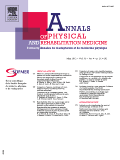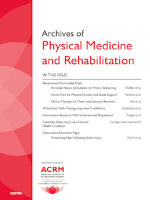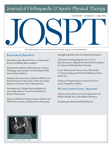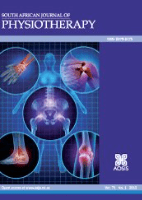
Turkish Journal of Physical Medicine and Rehabilitation
Scope & Guideline
Empowering practitioners with cutting-edge insights.
Introduction
Aims and Scopes
- Rehabilitation Techniques and Interventions:
Research exploring various rehabilitation methods including physical therapy, occupational therapy, and innovative interventions like telerehabilitation and robot-assisted therapies. - Chronic Pain Management:
Studies focusing on the assessment, treatment, and management of chronic pain conditions, including myofascial pain syndrome and osteoarthritis. - Neurorehabilitation:
Investigations into rehabilitation strategies for neurological disorders, including stroke, spinal cord injury, and multiple sclerosis, emphasizing functional recovery. - Musculoskeletal Disorders:
Research on the rehabilitation approaches for musculoskeletal conditions, including knee osteoarthritis, carpal tunnel syndrome, and sports injuries. - Patient Outcomes and Quality of Life:
Studies assessing the impact of rehabilitation interventions on patient outcomes, including functionality, quality of life, and psychosocial factors. - Innovative Therapies and Technologies:
Exploration of emerging therapies such as transcranial magnetic stimulation, low-level laser therapy, and the use of mobile health applications in rehabilitation. - Public Health and Epidemiology:
Research addressing the broader public health implications of rehabilitation practices, including the epidemiology of conditions treated and the effectiveness of rehabilitation strategies.
Trending and Emerging
- Telehealth and Remote Rehabilitation:
Research into the effectiveness of telehealth solutions, particularly in the context of the COVID-19 pandemic, has surged, showcasing the potential for remote rehabilitation to enhance patient access and convenience. - Integrative and Holistic Approaches:
There is a growing emphasis on combining traditional rehabilitation techniques with complementary therapies such as yoga, acupuncture, and dietary interventions, reflecting a more holistic view of patient care. - Focus on Patient-Centered Care:
Emerging studies emphasize the importance of patient experiences, satisfaction, and engagement in their rehabilitation journey, highlighting the need for personalized treatment plans. - Use of Technology in Rehabilitation:
Innovative applications of technology, including virtual reality and mobile health applications, are increasingly being investigated for their potential to enhance rehabilitation outcomes. - Impact of COVID-19 on Rehabilitation Practices:
Research exploring the implications of the COVID-19 pandemic on rehabilitation practices, including the impact on patients with chronic conditions and the adaptations made by healthcare providers.
Declining or Waning
- Traditional Rehabilitation Approaches:
There has been a noticeable decrease in studies focusing solely on conventional rehabilitation methods, as the field shifts towards more integrated and innovative therapeutic strategies. - Pharmacological Interventions:
Research on pharmacological treatments in rehabilitation settings has decreased, possibly due to a growing emphasis on non-pharmacological approaches and holistic treatment models. - Case Reports and Anecdotal Evidence:
The frequency of case reports appears to be declining, indicating a potential shift towards larger cohort studies and randomized controlled trials that provide more generalizable data. - Invasive Procedures in Rehabilitation:
There is a waning focus on invasive procedures such as injections for pain management, as non-invasive techniques gain more attention in rehabilitation practices.
Similar Journals

Annals of Physical and Rehabilitation Medicine
Exploring New Frontiers in Physical Medicine and RecoveryAnnals of Physical and Rehabilitation Medicine, published by Elsevier France-Editions Scientifiques Medicales Elsevier, stands as a leading peer-reviewed journal in the fields of Orthopedics and Rehabilitation. With its ISSN 1877-0657 and E-ISSN 1877-0665, this esteemed journal is known for its high-quality research articles that significantly influence clinical practices and advancements in rehabilitation medicine. Recognized for its impact, the journal is categorized in the Q1 quartiles for both Orthopedics and Sports Medicine as well as Rehabilitation disciplines. According to the Scopus rankings, it ranks #5 out of 161 in Rehabilitation and #20 out of 321 in Orthopedics and Sports Medicine, illustrating its critical role in shaping the future of these fields with a remarkable 97th and 93rd percentile standing respectively. With a commitment to excellence, the journal publishes innovative research that addresses the evolving needs of both practitioners and patients, making it an essential resource for researchers, professionals, and students dedicated to improving rehabilitation practices. The journal operates under conventional access options, ensuring that its groundbreaking findings remain accessible to a wide audience.

Physical Therapy in Sport
Exploring the synergy of therapy and performance in sports.Physical Therapy in Sport is a premier journal dedicated to advancing the field of physical therapy and rehabilitation in sports contexts. Published by Churchill Livingstone, this esteemed journal carries an impactful presence in the academic community, with a commendable Q1 ranking in categories such as Orthopedics and Sports Medicine, and Physical Therapy, Sports Therapy and Rehabilitation as of 2023. Spanning research from 2000 to 2024, this journal serves as a vital repository of evidence-based practices, innovative methodologies, and analyses pertinent to enhancing athletic performance and rehabilitation techniques. While it operates under a traditional access model, the insights presented are essential for researchers, practitioners, and students alike, aiming to stay at the forefront of developments in physical therapy and sports health. Located in Edinburgh, Scotland, Physical Therapy in Sport is committed to fostering a deeper understanding of the interplay between physical therapy and sports, making it an invaluable resource in this shifting landscape.

Turkish Journal of Physiotherapy Rehabilitation-Turk Fizyoterapi ve Rehabilitasyon Dergisi
Transforming lives through evidence-based rehabilitation.The Turkish Journal of Physiotherapy Rehabilitation (Turk Fizyoterapi ve Rehabilitasyon Dergisi), published by the TURKEY ASSOC PHYSIOTHERAPISTS, stands as a significant platform for the dissemination of research and developments in the fields of physiotherapy, rehabilitation, orthopedics, and sports medicine. Since its inception in 2018, the journal has been dedicated to advancing the understanding and practice of rehabilitation therapies, contributing valuable insights to both clinicians and researchers alike. Currently classified in the Q4 category across various relevant fields, including Orthopedics, Sports Medicine, and Physical Therapy, it reflects the evolving landscape of rehabilitation science. Although the journal is indexed in Scopus with ranks indicating its nascent stage, it serves as an essential resource for the academic community in Turkey and beyond. Researchers and professionals interested in innovative rehabilitation practices and advancements are encouraged to utilize this open access journal to share knowledge, fostering collaboration and growth within this critical area of healthcare.

International Journal of Sports Physical Therapy
Transforming the landscape of sports rehabilitation.Welcome to the International Journal of Sports Physical Therapy, a premier platform dedicated to advancing the field of sports therapy and rehabilitation. Published by the NORTH AMER SPORTS MEDICINE INST-NASMI, this open access journal has been vital in disseminating state-of-the-art research since its inception in 2011. With an ISSN of 2159-2896, it boasts a commendable standing within the academic community, achieving a Q2 ranking in 2023 across multiple categories, including Orthopedics and Sports Medicine, Physical Therapy, and Rehabilitation. Spanning diverse topics relevant to sports physical therapy, this journal serves as an invaluable resource for researchers, clinicians, and students alike, promoting best practices and innovative techniques in the field. By maintaining a commitment to high-quality peer-reviewed content, it not only contributes significantly to the existing body of knowledge but also fosters collaboration among professionals seeking to enhance patient care and rehabilitation outcomes.

Current Physical Medicine and Rehabilitation Reports
Advancing the Future of Rehabilitation ScienceCurrent Physical Medicine and Rehabilitation Reports, published by SpringerNature, is an esteemed academic journal dedicated to advancing the fields of physical medicine and rehabilitation. With a focus on disseminating high-quality research and evidence-based practices, this journal covers a broad spectrum of topics including orthopedic medicine, sports therapy, and comprehensive rehabilitation strategies. While it currently holds a Q3 quartile ranking across several related categories, including medicine and rehabilitation, the journal aims to elevate its impact through open access to its content, fostering a global discussion amongst researchers, professionals, and students alike. Navigating the intersections of innovation and clinical application, Current Physical Medicine and Rehabilitation Reports serves as a vital resource for those seeking to enhance their understanding and practice in this dynamic field. With its evolving scope, the journal is committed to publishing studies and reviews that shape the future of rehabilitation and physical medicine practices.

Balneo and PRM Research Journal
Elevating standards in rehabilitation and rheumatic management.Balneo and PRM Research Journal, an esteemed publication of the Romanian Association of Balneology, serves as a valuable forum for the dissemination of innovative research in the fields of physical therapy, sports therapy, rehabilitation, and the medical management of rheumatic conditions. With its commitment to Open Access principles since 2011, the journal ensures that groundbreaking findings are accessible to a global audience, promoting collaboration and advancing knowledge within the academic community. Despite its emerging status, as reflected in its Scopus rankings—with Physical Therapy, Sports Therapy and Rehabilitation ranked at the 25th percentile, and Rheumatology at the 21st percentile—the journal is positioned to make significant contributions to clinical practice and research. The journal is published in the heart of Romania, at Bucharest, and operates from 2021 to 2024, focusing on the intersection of balneotherapy and modern rehabilitation techniques. As a crucial resource for researchers, professionals, and students alike, Balneo and PRM Research Journal invites submissions that explore the latest advancements and clinical applications in these vital areas of health sciences.

Journal of Pain Research
Elevating Standards in Pain Research and ManagementJournal of Pain Research, published by DOVE MEDICAL PRESS LTD, stands at the forefront of the field of pain management and anesthesia, offering a critical platform for researchers and clinicians dedicated to advancing the understanding of pain and its treatment. With an Open Access model since 2008, this journal enhances accessibility to high-quality research, enabling a global audience to engage with innovative studies and findings. Recognized for its significant contributions, it has achieved a Q2 rank in Anesthesiology and Pain Medicine as of 2023, placing it among the top 30% in its category, and it holds a commendable Scopus rank of 41/136 in its field. Covering a broad scope encompassing clinical trials, pharmacology, and psychosocial aspects of pain, the journal invites submissions that advance both theoretical knowledge and practical applications, making it an invaluable resource for professionals, researchers, and students aiming to improve outcomes in pain management.

ARCHIVES OF PHYSICAL MEDICINE AND REHABILITATION
Elevating Standards in Physical Medicine and RehabilitationArchives of Physical Medicine and Rehabilitation, published by W B Saunders Co-Elsevier Inc., is a premier academic journal dedicated to the fields of physical therapy, sports therapy, and rehabilitation. Since its inception in 1945, it has evolved to provide a platform for groundbreaking research and insightful discourse that shapes clinical practice and enhances patient outcomes. With a notable impact factor and ranking in the top quartiles of its respective categories, this journal consistently showcases the most innovative studies, systematic reviews, and evidence-based practices that drive forward the understanding of rehabilitation medicine. As a vital resource for researchers, healthcare professionals, and students alike, it contributes significantly to the advancement of knowledge in rehabilitation sciences. With an aim to bridge the gap between research and practice, the journal invites contributions from all disciplines related to physical medicine and rehabilitation, fostering a collaborative environment that promotes the dissemination of impactful findings.

JOURNAL OF ORTHOPAEDIC & SPORTS PHYSICAL THERAPY
Leading the Charge in Orthopaedic and Sports Therapy ExcellenceJOURNAL OF ORTHOPAEDIC & SPORTS PHYSICAL THERAPY (JOSPT), published by J O S P T, is a premier peer-reviewed journal that has made significant contributions to the fields of orthopaedic and sports physical therapy since its inception in 1979. With an impressive impact factor and consistently ranking in the Q1 category for Medicine, Physical Therapy, Sports Therapy and Rehabilitation, and Sports Science in 2023, this journal stands at the forefront of evidence-based practice and innovative research. JOSPT aims to disseminate high-quality investigations, systematic reviews, and groundbreaking clinical practices that enhance both rehabilitation techniques and athletic performance. Notably, it ranks #12 among 247 in the Scopus database for Health Professions related to Physical Therapy, reflecting its influence and recognition within the academic community. As a comprehensive resource for researchers, clinicians, and students alike, JOSPT facilitates access to the latest developments in physical therapy, thereby promoting improved patient outcomes and advancing the science of rehabilitation.

South African Journal of Physiotherapy
Fostering Collaboration in Physiotherapy ResearchWelcome to the South African Journal of Physiotherapy, an esteemed open access journal published by AOSIS that has been serving the physiotherapy community since 2002. This journal is dedicated to advancing knowledge in the fields of Physical Therapy, Sports Therapy, and Rehabilitation, featuring a wide array of research articles, clinical studies, and reviews. With an ISSN of 0379-6175 and E-ISSN of 2410-8219, the journal is indexed in Scopus and has been classified in the third quartile (Q3) as of 2023, ranking #153 out of 247 within its category. Based in South Africa, the journal reflects the rich therapeutic landscape of the region and promotes international collaboration in physiotherapy research. By providing a platform for innovative ideas and practices, the South African Journal of Physiotherapy aims to foster excellence in education and practice among researchers, professionals, and students alike.